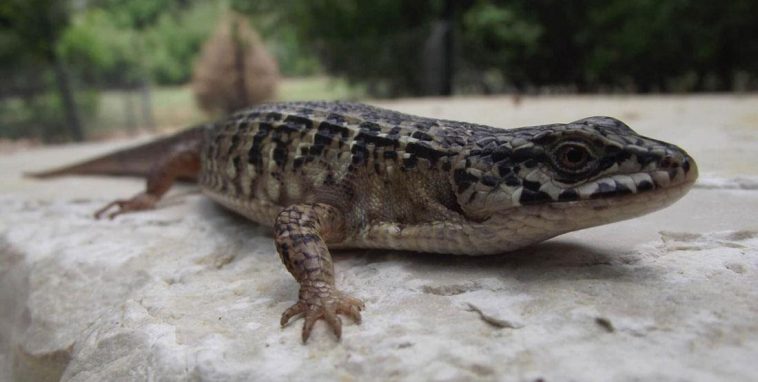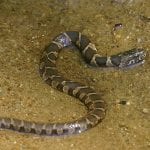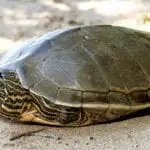Scientific Facts
| Common Name: | Northern Alligator Lizard |
| Scientific Name: | Elgaria coerulea |
| Life Span: | In captivity from 5 to 8 years |
| Size: | Adults from 3 to 6 inches plus the tail |
| Habitat: | Dry parts of forests |
| Country of Origin: | Pacific coast of the US, to the Rocky Mountains |
Physical Description
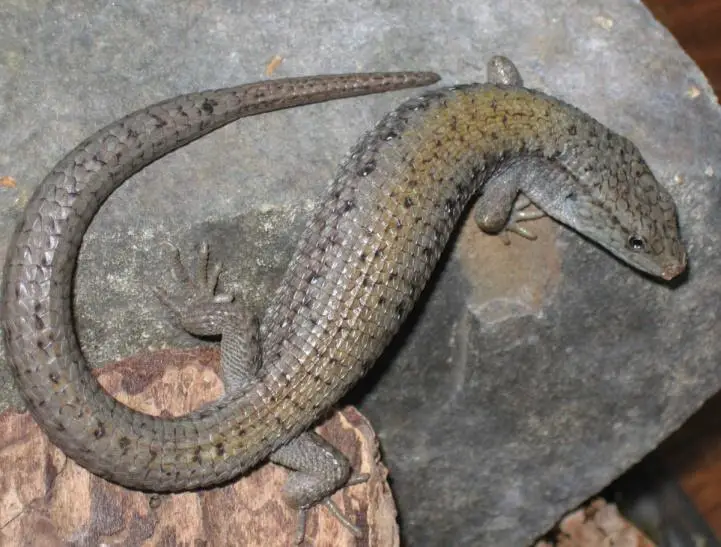
The Northern Alligator Lizard is a slender, medium-sized lizard that is native to the North American west coast. It was formerly known as Gerrhonotus coeruleus, but recently, it has been classified as the genus Elgaria.
Adult Northern alligator lizards can reach 10 cm with a total length from the snout to the end of the tail of 27.5 cm. These lizards come with a distinct skin fold found on each side of the body. This fold separates the scales on the back from the ventral scales.
The skin of the northern alligator lizard can vary in color from brown and white to green, yellow, and brown. Along the dorsal part of the lizard, you’ll find brownish scales with dark blotches that may come together to create bands. The lizard’s throat and mouth area can be yellow. The belly is a light shade of gray while the eyes are dark.
The northern alligator lizard is found along the Pacific Coast in the Rocky Mountains from the southern part of British Columbia to Washington, the northern part of Idaho, and in the western areas of Montana to Oregon. These lizards can also be found in the Sierra Nevada in central California.
The different subspecies of this lizard are widely distributed as well. Some are found across the mentioned areas while others are native around the areas of San Francisco and farther north to Humboldt County. This lizard species are widely distributed in the areas of the Pacific Coast. It lives in an area on sea level to an elevation of 10,990 feet.
Subspecies
The northern alligator lizard has four valid subspecies. This includes the nominotypical subspecies.
- E. c. coerulea by Wiegmann in 1828 which is a lizard native in San Francisco
- E. c. palmeri by Stejneger in 1893, which is a lizard from Sierra.
- E. c. principis by Baird & Girard in 1852, which is a Northwestern alligator lizard.
- E. c. shastensis by Fitch in 1934, which is a Shasta alligator lizard.
Life Span
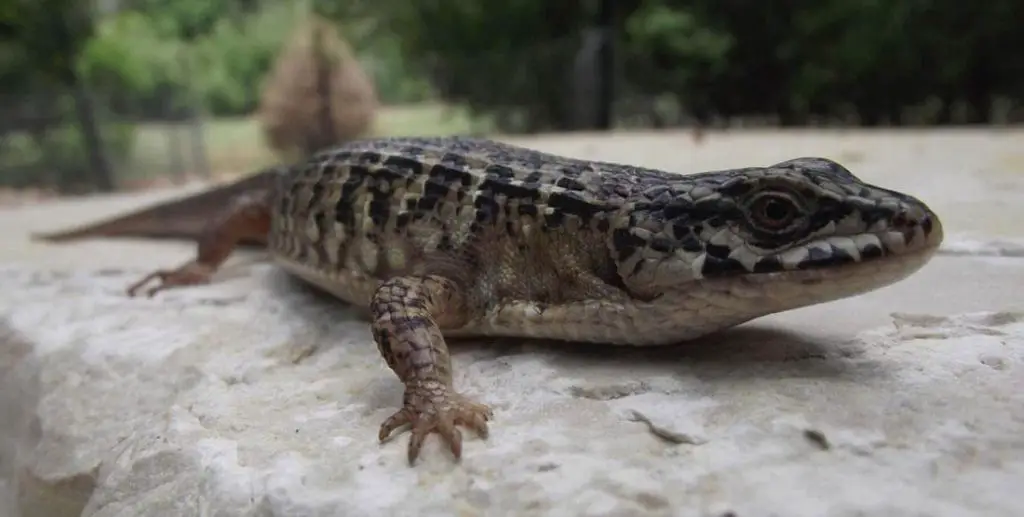
The Northern Alligator Lizard has three life stages just like other lizard species:
Newly born
A northern alligator lizard will bear live young; therefore, the babies do not hatch from eggs. Female bears around 15 babies and are born between June and September. A baby lizard is so small it may be around the size of a house lizard. It is mostly dark in color, and you can’t see any markings or other colors. Usually, newly born alligator lizards are already energetic and ready to look for their first meal.
Juvenile
During the juvenile stage, both male and female Northern Alligator Lizards have the same size, color, and shape. The once dark body will now develop distinct scales, colors, and blotches. The lizard is also longer, while the eyes are larger as well.
Adult
Adult Northern Alligator Lizards eventually becomes mature and ready to mate. The colors are brighter, and the distinct scales at the back and on the top of the head are also becoming brighter. The body is longer, and the tail is thicker as well.
The future of the northern alligator lizard
The northern alligator lizard is at the northern limit of its habitat; therefore, it is likely that these will be limited from living further due to harsh cold temperatures. The populations of lizards located at the end of its range are very important because these may carry different genes compared to lizards found in the central part of its native area. This can lead to the enhanced diversity of the northern alligator lizard.
Alligator lizards are every dependent on natural rock formations, and thus removal of these said rocks for construction and landscaping can affect the population of this lizard. These lizards are disturbed easily, and afterward, these will hide for many hours to avoid encountering predators or even humans. The northern alligator lizard is a sedentary creature in a way that these don’t move much between populations.
This lizard is not included in any endangered animal lists, but if people don’t stop bothering this lizard’s natural environment by construction and landscaping, it won’t be long when the numbers of this species start to decrease.
Eating Habits
In the wild, the diet of the northern alligator lizard ranges from crickets, moths, mealworms, and other smaller insects. This lizard can also eat larger prey like small lizards, pinkie mice, and more. In captivity, the northern alligator lizard is very hardy and can feed on invertebrates like crickets, slugs, spiders, and small bugs.
How it catches prey is quite ingenious. It will stalk it’s prey stealthily and then pounces on them when it has reached a short distance from its prey. It can climb trees to catch its food, or it can dig prey under the substrate.
To feed your northern alligator lizard, give food during the day right after it can bask under the lamplight or heat lamp. Lizards need time to increase its body temperature before it can move, hunt, eat, and mate. Check the tank or enclosure temperature before you feed your lizard. The temperature and humidity should be at the ideal levels before feeding.
Water
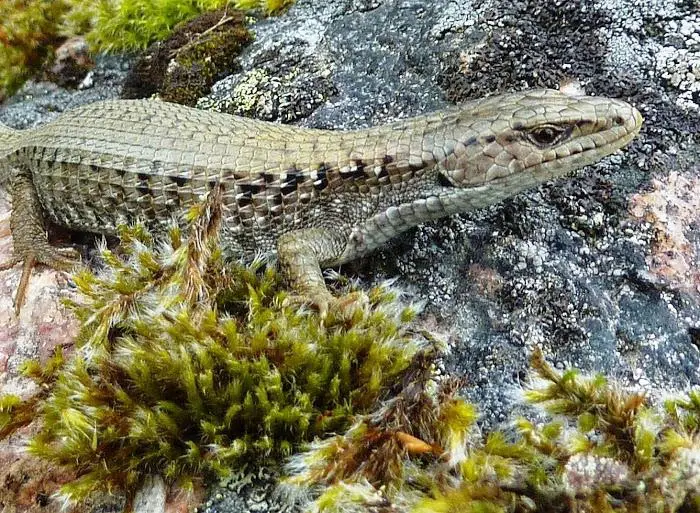
This lizard doesn’t need deep water to swim in, but they need water to drink. A shallow bowl of water is recommended, but it’s better if you spray water on the tank walls and plants inside the tank. It will lick the vapor of these surfaces instead. Spray at least twice or thrice a day because water is also needed to improve humidity inside the tank.
Development, Reproduction, and Breeding
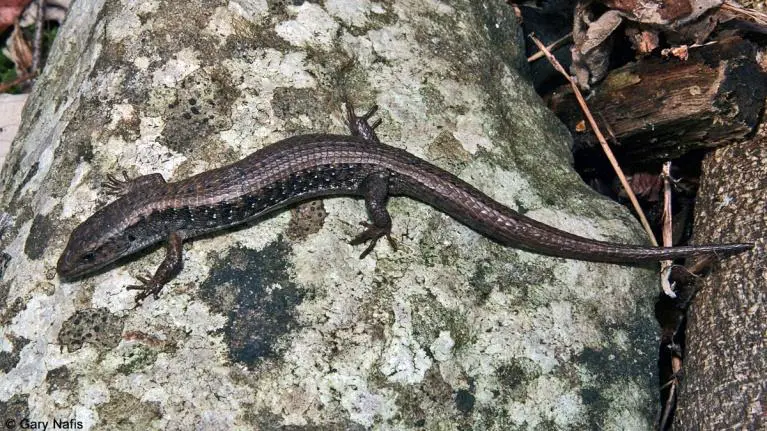
Female lizards reach sexual maturity around 32 to 44 months in the northern parts of California. Northern alligator lizards mate in April to May with only one litter produced every year. The size of the litter depends on where the lizard is located. In Seattle, a litter of 3 to 8 babies in Central Oregon coast 2 to 6 babies). Some species can give birth to up to 15 young between June to September.
During the breeding season, the male will hold the head of the female using its mouth. He won’t let go until the female finally submits to his advances and is ready to mate. It can take hours for this connection to last or until a female finally gives in.
This attachment can go for many hours; sometimes, the pair is oblivious to the surroundings. Experts say that the male northern alligator lizard does this behavior to prevent the female from escaping and to show her how strong he is. Strength is a factor that females look for in a suitable mate.
Usually, alligator lizards spend winters hibernating in underground areas called dens or hibernacula. When the lizards emerge from their holes in the spring, mating season commences. In northern parts of the world, northern alligator lizards will remain near their dens all year round.
After the female’s mate, her babies will develop inside her body and are born after three months after their eggs are fertilized, which is usually around mid-August and mid-September. Being pregnant and carrying her eggs in her body all summer long allows her to protect her babies from changes in temperature and humidity. Inside the mother lizard’s body, the temperature and humidity remain constant. But because of this, female lizards may have a hard time to eat; as a result, she has to bask more often. Northern alligator lizards mate every two years and may need a year after breeding to grow, eat and regain their fat stores.
Common Health Problems
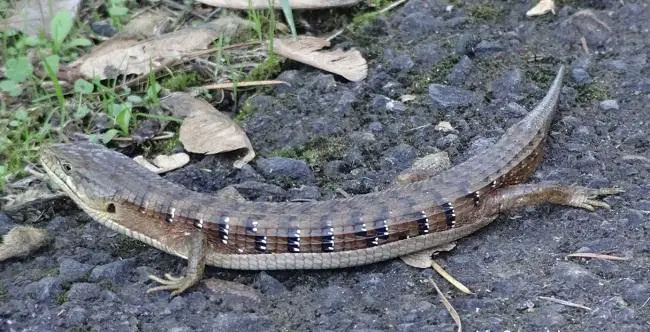
Here are the common problems that Northern Alligator Lizards experience:
Parasites
Reptiles like lizards come with parasites that at first may have no effect on their health, but when the lizard feels stressed or suffer any immune system condition, these parasites can cause dangerous life-threatening diseases.
These parasites can multiply and affect the lizard’s health. Also, these may affect other animals and humans. You can stop parasites and infections from spreading by quarantining a new lizard. A new pet or a new lizard is the usual cause of parasites, and placing it on quarantine will help reduce parasites greatly in the enclosure or tank.
Always check for signs and symptoms of parasitic infections like smelly or runny poop, weight loss, an enlarged abdomen, anorexia, and poor energy.
Incomplete shedding
Check for signs of incomplete shedding difficulty like skin flakes, skin clinging on the tail or the eyes, and any signs of restlessness. Stuck skin should be removed right away. You may soak your lizards in a dish of warm water for a few minutes. And for any severe shedding, consult a vet. A vet can remove stuck skin and will treat wounds or cuts due to incomplete shedding.
Metabolic Bone Disease
MBD is a very common health condition in reptiles and other egg-laying animals. It is the lack of calcium in bones and symptoms which may occur over time and may show acute symptoms like bowed legs, a rubbery jaw, and kinks along the spine. Also, females that hatch eggs, as well as live young like the Northern alligator lizards, require increased calcium in their diets.
MBD can be reversed by increasing vitamin D3 and calcium. You may use calcium supplements and proper UV lighting to improve vitamin D3 levels in the lizard’s body.
Preventing Illness
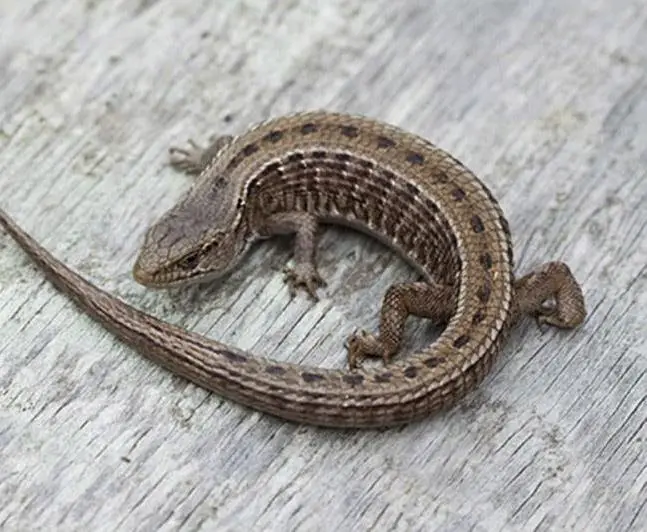
The most important way to prevent illness is to keep the tank temperature and humidity at the ideal levels. This is needed by li
Place a bowl of water in the tank because this will not just be its water dish but also a way to enhance humidity inside the tank. This is needed for improved overall health and to enhance shedding. You must keep your tank clean because a dirty tank can lead to the growth of bacteria, and this can affect the health of your lizard. A good cleaning product is important. Don’t use products that contain residue and toxins which can harm your lizard.
Provide the best food for your lizard. When it comes to insects and mealworms, these have to be organic. Never capture insects and worms in your yard because these could have toxins coming from pesticides, which can affect the health of your lizard. Use live insects to gut feed your lizard to give your lizard supplements and nutrients.
Always quarantine new lizards. These new pets may bring pests, mites, and parasites, so you must monitor its health before you introduce it to the main tank. How long the lizard stays in the quarantine may depend on you. You can wait until a week or a month to quarantine a new lizard.
Behavior
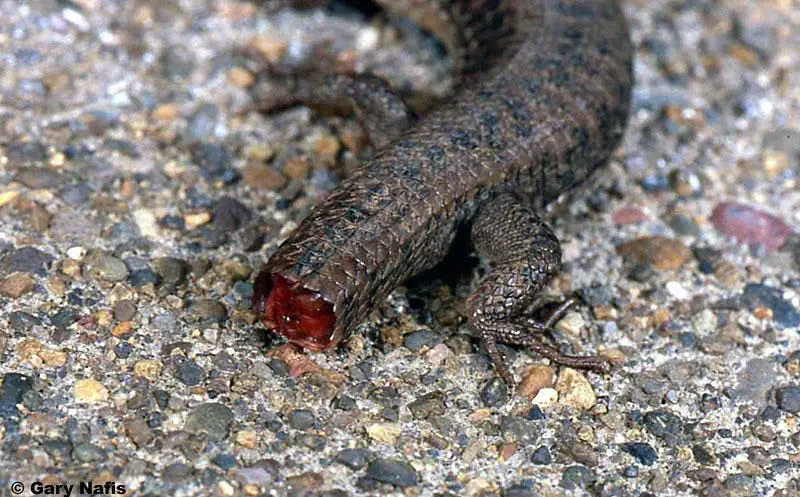
The following are common behaviors of northern alligator lizards:
Smart and Secretive
The alligator lizard is known for being a cunning lizard. It will use all its defenses just to remove itself from any threat. If faced by a threat, its first defense is to run and to hide someplace; it can’t be seen or easily captured. It runs fast, so predators usually don’t bother catching up.
Aside from its speed and determination, the alligator lizard still has a few tricks up its sleeve like tail dropping and smell attack.
Smell Attack
Northern alligator lizards have this smell attack. If they are captured by a predator, a lizard may release a smell attack, which is a mixture of the smell of musk and feces. The smell is so strong that predators may find it hard to breathe and to hold the lizard. It will release this smell when it feels threatened, too, and usually, after the predator lets go of it, it will bite.
A northern alligator lizard may also spray this smelly attack to its handler if it feels threatened. Usually, this happens during the first months that you are handling it. Don’t worry because soon your lizard will gradually warm up to your handling.
Can Drop Its Tail
Just like most lizards, the northern alligator lizard can drop its tail on command. The alligator lizard will do this as a last resort, especially when it is held by its tail. The dropped tail is a decoy, and this usually distracts the predator. The lizard will grow its tailback, but this will be shorter and fatter.
The lizard’s tail is a very important source of fat. During hibernation, this tail becomes thinner as the lizard uses its fat reserve to survive this long and cold season.
Will Hibernate
Alligator lizards spend their winter hibernating inside their underground den. And just like most animals that undergo hibernation, these lizards will eat a lot before winter to prepare their bodies. After hibernation, these will emerge from their dens to immediately start to mate. Hibernation is a natural adaptive mechanism of reptiles like lizards. Your pet will hibernate during the winter if you live in a country where there are four distinct seasons. But if you’re located in a country where there are only two seasons, your lizard may not hibernate.
How to prepare for hibernation: feed your lizard protein-rich food weeks before hibernation. Monitor the temperature and humidity inside the tank. Spray the tank with water to help maintain humidity. A lizard that hibernates without its tail may find it hard to do so because the tail is where reserved fat is stored.
The Mating Chase
The mating chase happens in alligator lizard species. As mentioned, the lizards look for potential females, and when they find one, they bite its head. This biting can go on for many hours until the female submits. The lizards can be attached this way for many hours, running, wrestling, and often oblivious to their surroundings.
Mating commences after the female gives in to the male’s advances. The female may suffer from injuries during this time, and sometimes she may have injuries that can cost her tail. Lizards, like the northern alligator lizard, can lose its tail when it’s stressed or threatened. But this will grow back but not the same size and shape as the original tail.
Stronger Males
Females choose their mates by their strength. If they can escape the mating dance and the biting, it means that the male is weak and is not suitable for them. But if the female submits to the male, it means that the male is strong, and it is a good choice as her mate.
Basking and Soaking
Lizards like the northern alligator lizard need to bask to warm up. Basking and soaking are done in a group activity, but as mentioned, the lizards don’t interact with each other and just mind their own business. Alligator lizards often bask on logs, under a rock, or the heating lamp in enclosures.
Excellent Climbers
These lizards can climb trees well. This is a skill that these have developed well to be able to escape their predators. The alligator lizard has predators on land as well as on-air, but they use their quick climbing abilities to escape. Even in captivity, these lizards can learn how to climb well if you place these in an enclosure where there are branches and logs, shelves, and rocks.
Shedding
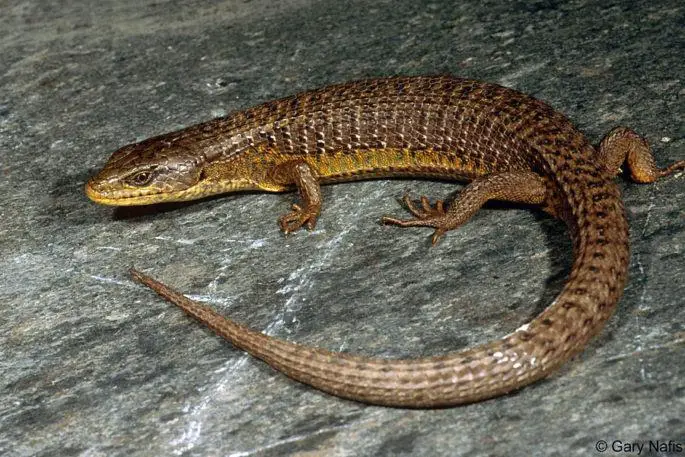
Shedding should be complete or should happen in one go from head to tail. But some lizards may suffer from incomplete shedding.
In incomplete shedding, parts of the tail, hands, feet, and eyes shed in flakes and skin may be hard to remove in some areas of the body as well. Usually, incomplete shedding can indicate problems with humidity and metabolic conditions.
To treat incomplete shedding and to help shed completely, you must improve humidity levels inside the tank. You may also place your lizard in warm water for at least a few minutes to loosen dead skin. Take note that shedding may happen in juveniles and less frequently in adults. Shedding is stressful to most lizards, so leave your pet alone and intervene only when there are problems. Take your pet lizard to the vet for any problems with shedding.
Habitat
The ideal tank size is a 20-gallon enclosure or terrarium. Place one or two lizards in the tank, but during breeding time, place one male to more females to ensure success inbreeding.
You must place a cover at the top using a screen to prevent these slippery lizards from escaping and from other pets entering the tank. Always secure the cover with a lock to secure the tank. You should place the lizard tank in a quiet environment so that your pet can remain quiet and stress-free.
In the wild, it’s a different thing for northern alligator lizards. These animals can be seen basking along with the sunny areas or soaking under warm rocks. Usually, these lizards are in groups, but when you look closer, there is almost no interaction that happens between individual lizards.
In their wild habitat is also where this lizard is in danger from predators. The common garter snake and the western terrestrial garter snake are two of the most common predators. Also, common house cats, red-tailed hawks, other snake species, and shrikes can prey upon northern alligator lizards.
Lighting, Humidity, and Temperature
The Northern Alligator Lizard needs a good lighting system. Incandescent light is the best choice for a small tank or enclosure. High-powered lamps will be ideal for a larger tank. Place your lizard in a minimum of 12 hours of light to mimic daylight. This is the best amount of light to enhance the health and tank environment.
Use an under-cage heating pad to maintain tank temperature. This will keep the tank interiors at 75 to 90 degrees Fahrenheit, especially in the morning and 85 to 90 degrees at night. One way to enhance humidity is to apply a spray of water. Spray water several times a day to ensure that the tank remains humid.
Use a humidifier for a more accurate humidity reading. A bowl of water is a good way to maintain humidity. Tie the bowl of water to the tank to keep from being knocked over. Keep your lizard’s water clean and fresh daily.
Tank Bedding and Accessories
Northern Alligator Lizards should have dens like where it resides in the wild. A small hollow log will do. Cut this in the best size and place this inside the enclosure or tank. You can create as simple or an elaborate enclosure or tank just remember that an elaborate tank is harder to clean, and it is also hard for you to see your pet.
The accessories inside the tank should be safe, must have no pointed edges which can injure your lizard. Your pet’s health is foremost, so don’t place complicated accessories. Place one den near the heat source and one farther away in case your lizard wants a cooler area to sleep on.
For the bedding or substrate, use paper for easy cleanings such as newspaper, butcher, or packing paper or paper towels. Remember that a Northern alligator lizard will hibernate during the cold months, so adding a secure and comfortable area where it can sleep and rest is a must.
Sanitation
Maintain your lizard’s cage with natural and safe cleaning solutions. You can choose homemade cleaners or commercially available cleaners. Homemade cleaners like baking soda, lemon and vinegar are effective and natural. Another good idea is to use dishwashing soap, bleach, and water. And even when these are natural cleaners, rinse everything before you place the lizard back inside the tank. Baking soda and lemon can clean the tank and deodorize it as well.
To use chemical cleaners, follow the instructions on the label carefully. Always rinse well with running water. Use paper towels or a clean towel to dry the walls, flooring, and accessories. Clean filters, humidifiers, and fans regularly if you use these to maintain your lizard’s tank.
Availability – Where to Get One?

You can get a Northern Alligator Lizard from a pet store or an online reptile trade shop. The price for a regular Northern Alligator Lizard is around $50 to $75 depending on the size, color, gender, and age. You can buy alligator lizards for a lower price if you purchase from a local supplier.
The cost of shipment and delivery affects the cost of a northern alligator lizard. This is why most pet owners decide to buy their pets from a local pet shop or directly from a supplier.
How to Care for a Northern Alligator Lizard
Northern alligator lizards should be cared for with the following techniques:
- Keep the tank humid to prevent illnesses, enhance shedding, and to keep your lizard healthy. For you have a bigger tank, use a humidifier to control humidity digitally. Correct lighting also improves humidity, so be sure to apply proper lighting conditions inside your lizard’s tank.
- Keep the tank in a quiet area when the lizard is asleep and especially during hibernation. Feed your lizard only when it’s awake and energetic. Since lizards are diurnal, find out your lizard’s preferred time to eat before you feed it.
- Change your substrate frequently to prevent mold, bacteria, and parasites. You can use soft soil for the substrate to mimic the natural environment of this lizard. Don’t use sand.
- Learn how to handle your lizard early so it will trust you and will be calm when you hold it even in public. You must handle it early during the early and juvenile stages.
- Avoid overcrowding, so use a larger tank or enclosure. As much as possible, place one lizard in one tank to avoid crowding and from aggression. You may use smaller tanks for breeding.
- Regularly change the water inside the bowl. Keep water fresh and clean. Never remove this inside the tank because this improves humidity.
- Take your pet to a reptile specialist or an exotics vet regularly, especially when it’s sick, wounded, or lethargic.
- Beware of salmonella. Some lizards carry this parasite and may still appear healthy. To completely avoid salmonella, wash your hands before and after handling your pet. The same goes for other reptiles.
FAQ Section
Do alligator lizards hibernate?
Yes, northern alligator lizards do hibernate. In the wild, these lizards will stay inside their underground dens and sleep the entire winter through. And just like any animal that undergoes hibernation, this lizard needs to bulk up, storing fat and protein as the climate begins to cool.
Are alligator lizards poisonous?
Alligator lizards are not poisonous. These may bite threats and may also bite humans, but these bites are non-lethal and will only wound you. Usually, young wild lizards have a higher tendency to bite because these have not felt the gentle handling of human caretakers.
Are northern alligator lizards dangerous?
No, alligator lizards are not dangerous; these lizards are common prey to birds, snakes, and even to common house cats. But these can bite you if you corner them and they feel threatened by your presence so never attempt to do this.
Will an alligator lizard bite?
Yes, an alligator lizard can bite, and the bite can be too severe to cut skin and to cause wounds. An alligator lizard will only bite when it feels very threatened, and usually, it will just back out and run away.
How long can a northern alligator lizard live without food?
A northern alligator lizard can live for months without food, as evidenced by its ability to survive during hibernation. The lizard’s tail is vital to its survival since this contains fat reserves that the lizard can use. Without its tail, it won’t survive for a very long time without food.
Can northern alligator lizards eat fruit?
No, alligator lizards are carnivores. Its diet is typical of a lizard that it will eat small invertebrates, bugs, moths, and other small insects. If you have a captive lizard, feed it bugs that you have cultured yourself or look for suppliers of organic mealworms and other lizard food.
How do you distinguish from a male and female alligator lizard?
A male northern lizard has a swollen base of the tail compared to females. Males also have a pair of large scales located near the cloaca. Males have a brighter color than females and juveniles.
Can an alligator lizard lose its tail?
Yes, an alligator lizard is like other lizard species that it can lose its tail if it feels threatened. Usually, alligator lizards drop their tails when they are held by the tail, but don’t worry because a new one will grow in its place.
Will the new tail look like the old tail?
As with all lizards that lose their tails, the northern alligator lizard will lose its tail only to grow another one that looks very different from the original tail. The new tail will be rounder and thicker, and usually, it’s sometimes likened to the head of the lizard.
Can an alligator lizard lose its legs?
A lizard can grow its tail back but not its leg. When a predator bites its leg, it will never grow back, and oftentimes, the lizard will be left bleeding and dead.
Is an alligator lizard change gender?
No, an alligator lizard cannot change gender, but some reptiles can determine its gender according to where the female lays her eggs. If she lays her eggs in a cold area, then the clutch will likely be males, and when it lays its eggs in a warm area, the babies will likely be females.
Can female alligator lizards lay eggs?
No, northern alligator lizards don’t lay eggs; instead, their babies develop inside the body where these will hatch after a few months. She will give birth to live babies and not to eggs.
Is giving birth to live young better than laying eggs?
In northern alligator lizards, keeping their young inside their bodies where they develop is an adaptation. Inside the mother’s body, the young are safe and kept from temperature and humidity changes.
What can kill a lizard?
Lizards can become pests if these settle in your home and multiply. There are home remedies to kill or keep lizards away from your home, and these include coffee powder, tobacco powder, eggshells, pepper spray, onion, garlic, naphthalene balls, and tabasco sauce.
Can you keep an alligator lizard as a pet?
Yes, these exotic animals may be kept as pets for as long as you know how to take care of them. Handling your pet lizard is a very important thing for any owner because if these are not handled well, these can become aggressive and will bite.
Is it legal to own a northern alligator lizard as a pet?
In most places or countries, northern alligator lizards can be kept as pets, but you must be certain. Consult a vet in your area or contact a local animal department office to find out. If this is not allowed, you must never keep this as a pet or buy from illegal traders.
What can attract a lizard to come into your home?
A lizard usually goes into a home when it’s attracted to the light or the warmth of a home. If the climate is cold, a lizard will be looking for a suitable place to stay, and it may use your home as its new den because it’s warm and conducive to hibernation.
What do lizards do at night?
In captivity, lizards like the northern alligator lizard may hunt at night if this is what it’s used to do, or it may sleep like its human handlers. It may depend on the climate of the area too.
Can a lizard sleep?
Scientists have found the area in the brain of lizards that shows that it can sleep. In fact, humans and lizards share a similar sleep pattern; the length of the cycle may vary since a deep sleep for lizards lasts for only 80 seconds.
Is a northern alligator lizard nocturnal?
Most lizards are diurnal, which means these are active during daytime and inactive at nighttime. Some species are nocturnal, which means these are active when the sun sets.
Can a northern alligator lizard see in the dark?
Yes, northern alligator lizards are capable of seeing things in the dark but not as good as inside a bright room. Their eyes are highly developed and will be able to see better, especially to see their insect preys.
Are alligator lizards good pets?
Alligator lizards can be good pets, but only when you handle your pet early. If you don’t handle your pet early, this will continue to have a wild nature and may even bite you if you don’t do this soon.
Can alligator lizards distinguish its owner?
There are some reports that alligator lizards can recognize their owners; some people also say that their pets can follow them anywhere they go and are calm and happy pets.
Can alligator lizards hear music?
Studies show that alligator lizards and most lizard species can hear sounds from 100 to 5000 Hz, but the best level is from 400 to 1500 Hz. Lizards have a tympanic membrane, a hearing cavity, and a Eustachian tube, which may be used to hear noise and music adequately.
How to catch an alligator lizard?
To catch an alligator lizard, approach it slowly and herd it to a corner or anywhere that you can limit its movements. The first defense of an alligator lizard is to flee, so you better be ready to run after it with a net in case it escapes.
What smells bad to lizards?
There are many smells that lizards hate; one is the smell of garlic because this has a strong, pungent smell. If you don’t want lizards to enter your home, place garlic cloves in the entrance of your home to deter them.

